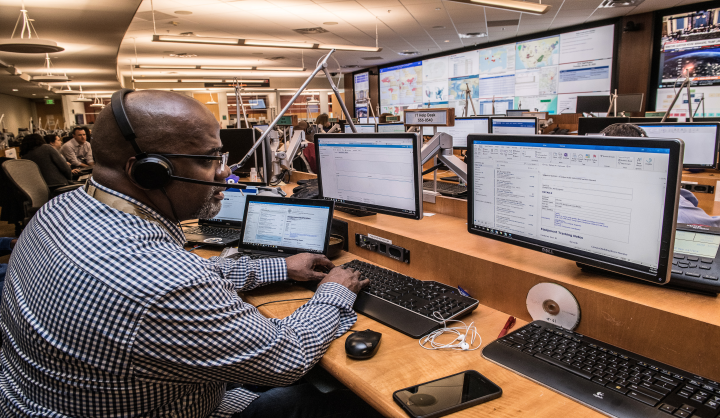- January 11, 2017
- 311
Overcoming data system silos is a vital step in achieving data-driven governance and a top priority for Mayor Eric Garcetti and the City of Los Angeles. Rooted in older systems that lack interoperability, data silos significantly slow down operations by causing miscommunications and duplication.
The City of Los Angeles’s veteran 311 service request systems, which connect requests for city services to the appropriate departments, clearly demonstrate the challenges that result from such silos. The service request systems in each department were designed with the department’s needs in mind, rather than cross-departmental service delivery operations. The four systems were custom built and designed before APIs and system interoperability were required features, leading to completely independent systems that were unable to exchange information. City officials looking for service request information to improve performance would have to contact each department individually, as there was no central database from which to pull information. As the city adapted to new technological trends — central call centers (311), mobile apps, and open data — the legacy systems’ antiquated architecture endured, becoming the primary obstruction to innovation.
Recognizing the essential role that the 311 service center plays in improving livability, Los Angeles recently modernized its 311 system, MyLA311, by consolidating four key service management systems into one integrated whole. For the first time, residents, civic hackers, and city departments can access all requests and status updates in one place. This is no small feat; the process included an extensive overhaul that required cross-departmental cooperation and sophisticated engineering to complete.
Technological Improvements Have Major Impact on Sharing Data
This new centralized system illustrates how technological improvements to our most integral city systems can have an immediate impact on operations and transparency. The central system improves data access, increases efficiency, and ensures a uniform tracking methodology across all departments for 51 service request categories.
The Los Angeles Mayor’s Office and the Information Technology Agency (ITA) led the centralization effort and convened a steering committee comprised of LA Sanitation, the Bureau of Street Services, the Bureau of Street Lighting, the Board of Public Works, the Chief Administrative Officer, and council representatives. The Mayor’s Office for Budget and Innovation, including former Chief Technology Officer Peter Marx, led the effort with the goal of increasing efficiency by addressing the technical hurdles that slowed service delivery. The committee met regularly for three years to bring the project to fruition and ensure a smooth migration to the new system. The project centered on integrating the departments’ disparate systems into one central repository and simultaneously creating tools to increase accessibility for back-end users (departments). ‘The new system enables real-time field-level data management that allows tickets to be updated and closed in the field,” explained Eduardo Magos, an ITA senior systems analyst who led the modernization project.
This process is not only more efficient for the city, but it also opens up data that was previously locked up in legacy systems. “Having a single repository of record for service requests facilitated the sharing of data with other systems such as the Open Data Portal,” said Magos. Now, open data users can analyze up-to-date 311 requests directly from the Los Angeles Open Data Portal. MyLA311 filtered views have quickly become the most desired datasets on the portal, with nearly 1,700 views. Civic hackers and data scientists use the data to map requests across the city and run analytics on trends in requests. A recent meetup at IBM’s Glendale office focused exclusively on 311 data analytics and teams comprised of students and data science professionals presented on a range of topics including the spatial distribution of service requests, the relationship between service requests and crime, and weekday versus weekend trends in requests. Data scientists at the meetup agreed that the data was enlightening and could be used to get a pulse on livability and community engagement across Los Angeles.
MyLA311 Furthers Mayor Garcetti’s Data-Driven Governance
MyLA311 is a compelling example of Mayor Garcetti’s responsive and responsible government at work. When the mayor took office in July 2013, he vowed to transform government by implementing a set of priorities that would guide the direction of his administration and make Los Angeles a leader in data-driven governing.
The MyLA311 repository demonstrates how these priorities, known as the mayor’s “Back to Basics” agenda, translate into action. By connecting legacy systems into one repository, Mayor Garcetti can now track service delivery across departments and his team can quickly analyze how well the city is doing in delivering quality customer service to every resident in Los Angeles.
With this vision, the Mayor’s Data Team, led by Chief Data Officer Lilian Coral, has developed a real-time Mayor’s Dashboard that is open to the public. The dashboard uses open-source platforms, tracking key metrics and outcomes from Los Angeles. The online tool can quickly pull relevant metrics on wait times, bulky item pick ups, and other service request data to help Mayor Garcetti and other city officials make important decisions about resource allocation and customer care. Before departmental integration, there was a delay in service delivery and lack of clarity and transparency. Now, data is more accurate and Los Angeles has dramatically reduced the wait time for 311 service requests.
Departments are also using the repository to improve service delivery in keeping with Mayor Garcetti’s priorities. Recently, the 311 team in ITA launched a data mining effort to identify emerging requests that are currently categorized as “other.” Through their data mining work, the team discovered that abandoned vehicle requests comprise the majority of “other” requests. With this insight, the team is actively working with the Department of Transportation (LADOT) to add them to the central repository. This way, LADOT can immediately flag these requests as they come in and accelerate their service response.
The repository is a major step forward in cross-departmental data sharing in Los Angeles. However, Magos and his team haven’t packed up yet; they continue to iterate and improve the repository’s features. They recognize the importance of an adaptable system to maximize the city’s trove of data so that the departments, civic tech, and residents can benefit to the fullest.





